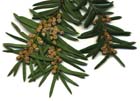
Foliage and pollen cones from an ornamental tree, Seattle (USA) [C.J. Earle, 1999.03].
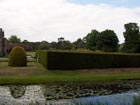
A yew maze at Hever Castle, UK, planted ca. 1905 [C.J. Earle, 2010.06.15].
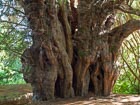
The Ankerwycke Yew, UK, one of the designated Great British Trees. Basal girth is about 8 m. Located across from the Thames River at Runnymede, where the Magna Carta was signed in 1215 [C.J. Earle, 2010.06.16].
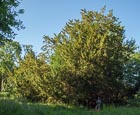
Another view of the Ankerwycke Yew, showing the entire tree. That's Aljos Farjon standing at the base of it [C.J. Earle, 2010.06.15].
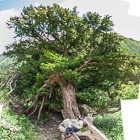
The largest of the four Borrowdale Yews, Cumbria, UK. These trees were the subjects of Wordsworth's poem "Yew Trees". This particular tree was heavily damaged during a storm in January 2005, but at the time of this photo, in 2010, still seemed quite healthy [C.J. Earle, 2010.06.19].
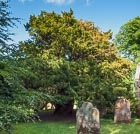
Crown of the Great Yew at Beltingham, Northumberland, UK [C.J. Earle, 2010.06.19].
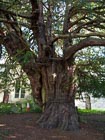
Stem of the Great Yew at Beltingham. An 1884 newspaper account noted the presence of the iron band to strengthen the tree [C.J. Earle, 2010.06.19].
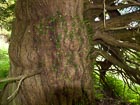
Epicormic sprouts on the trunk of one of the Borrowdale Yews. Its prolific ability to sprout in this way may be one reason yews are often used as symbols of eternal life [C.J. Earle, 2010.06.19].
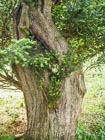
Note the fused branch. The ability of yew to fuse with itself, to sprout from virtually any living bark surface, and to send roots into its own decaying wood, allows a tree to persist as a living individual for a much longer time than can be recorded by the tree's own rings. Thus it is extremely difficult to derive an accurate age estimate for an old yew [C.J. Earle, 2010.06.20].
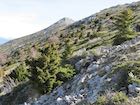
Yews in habitat covering a hillside in the Cantabrian Mountains of northern Spain [Miguel A. Vizcay, Facebook post 2020.02.28].

A Steinway piano with a yew veneer case.

Taxus baccata
Linnaeus 1753
Common names
European, English, or common yew (Hartzell 1991).
Taxonomic notes
The hybrid T. baccata × T. cuspidata is T. × media (Hils 1993). All yew species are quite similar. Pilger (1916) described them all as subspecies of T. baccata, reserving subspecies eubaccata for the populations treated here.
Description
Primarily dioecious evergreen trees 10-20(-40) m tall and up to 4 m dbh. Crown normally pyramidal, becoming irregular with age; but many cultivated forms depart dramatically from this. Bark thin, scaly, brown. Leaves flat, arranged spirally but appearing 2-ranked, 10-40 × 2-3 mm, dark green. Pollen cones globose, 3-6 mm diameter, shedding pollen in early spring. Seed cone consists of a single seed surrounded by a soft, bright red aril 8-15 mm long. Arils mature gradually 6-9 months after pollination, and seeds are dispersed by birds (L'Herbier Virtuel 2008).
Distribution and Ecology
Britain to N Iran (Silba 1986); widely cultivated in North America (Hils 1993), and naturalized in USA: Washington (PLANTS database 2009.03.31). Hardy to Zone 6 (cold hardiness limit between -23.2°C and -17.8°C) (Bannister and Neuner 2001). In Croatia, Slovenia, and Poland, it is protected by law.
Remarkable Specimens
The Fortingall Yew in Perthshire, Scotland, has a nominal girth of 15.8 m. The trunk is riven in two halves and much of the heartwood is gone, so this figure implies a substantially greater basal area than the tree in fact possesses. It appears (based in a photograph in [Hartzell 1991]) to be about 13 m tall with a crown spread of about 20 m (Hartzell 1991).
Data on two other U.K. trees are: 29 m tall and 89 cm dbh for a tree at Belvoir Castle, Leics.; and 13 m tall, 334 cm dbh for a tree at Ulcombe Church, Kent (Mitchell et al. 1990).
Some yews in a special reserve in Hosta, on the Russian coast of the Black Sea (formerly a sacred grove of the Shapsug people), are more than 40 m tall (Vladimir Dinets e-mail 1998.01.10).
The yew is a fine example of a tree to which great age is often attributed without much in the way of hard evidence. The oldest known yews have invariably lost most of their heartwood to decay and in any event tend to be isolated individuals, usually growing in places that have been regarded as sacred since before the Christian era. Consequently, tree ring-based age estimation is usually impractical or impossible. A few researchers have tried to estimate ages by extrapolation from observed growth rates, a very dubious proposition in view of the fact that when tree ring data are available they usually show extrapolated age estimates to be gross exaggerations. Nonetheless, it seems very likely that many of the largest yews encountered around the Christian shrines of the British Isles were in fact planted during the pre-Christian era by Celtic groups who saw the yew as sacred. It is therefore plausible that yews aged 2000 years or more occur in the British Isles. An age of 4000 years has been attributed, without much basis, to the Tisbury Yew in Wiltshire and the Crowhurst Yew in Surrey, both in England (Hartzell 1991).
Ethnobotany
The oldest known wooden tool is a spear made of yew wood, about 400,000 years old, from Clacton-on-Sea, England (Allington-Jones 2015). Archeological excavations have found found yew bows and knives in Swiss lake dwellings from 10,000 years ago. Historically, yew bows were the weapon of choice for both hunting and warfare throughout most of Europe until the invention of firearms. Yew was also employed in a less forthright manner, as a poison, used for assassination, suicide, as an arrow poison, and to poison fish and mammals. Due to its hardness, yew wood was used for shuttles, cogs, axle-trees, and pulley-pins. The colorful wood (red heartwood, white sapwood) was used to veneer furniture, to make lute bodies, bowls, tankards, combs, tool handles, pegs, and various art objects. As noted below, it was used in many ways by various religions, and certain yew objects such as drinking-cups are still regarded as having a certain spiritual potency. It was used medicinally to treat viper bites, hydrophobia (rabies) and heart ailments, and as an abortifascient. Currently, its principal use is as an ornamental plant. Many cultivars exist, and it is a preferred subject for topiary. It is also known to contain the anti-cancer drug taxol, but has not been widely exploited in this connection (Hartzell 1991).
The foliage and seeds contain several alkaloids, in particular taxine, very poisonous, which alters to hydrotaxine by hydrolysis; also one glucoside, taxicatine. The wood, bark, foliage and seeds are toxic. The foliage is the principal source of taxine. Old and desiccated foliage is more poisonous than young and fresh foliage. Poisoning is frequent in animals. Horses, asses and mules are extremely sensitive and can be killed in less than one hour. Rabbits, guinea-pigs and cats are insensitive to taxine. In humans, the yew generates digestive, nervous, respiratory and cardiovascular disorders which can result in death. Symptoms include excitation, hyperventilation, and tachycardia, followed by deceleration of the heart, hypotension, nausea, stomach pains, cramps, giddinesses, colic, violent diarrhoea, dizzy spells, convulsions, coma and death (L'Herbier Virtuel 1999-2008).
The red aril surrounding the seed can be eaten just as it is like delicacy with the proviso of not chewing the seed. It is sweetened and very mucilaginous. The arilles, removed from their seeds, have diuretic and laxative effects (L'Herbier Virtuel 1999-2008).
Taxus baccata has played a major role in several religious traditions. This may have occurred because the tree is poisonous, valued for a variety of medicinal purposes, and symbolic of eternal life due to its evergreenness, exceptional longevity, and the wood's resistance to decay. Thus the tree unites death (by poison) with eternal life, a concept well explored by Laqueur (2015). The Greeks wove funeral wreaths from it in honor of Hecate, whose dominion was death. The Celts used its wood for for votive and funerary artifacts, planted it in their holiest shrines (or perhaps chose its groves to site those shrines), and attributed to it a host of magical properties memorialized in their folklore. Following conversion of the Celts to Christianity, many of the Celtic shrines were appropriated as sites of churches and other Christian shrines, and ancient yews resident at these locations were preserved - perhaps to further legitimize the new religion. Whatever the reason, this cultural preservation of ancient yews accounts for the existence of the oldest and largest known individuals (Hartzell 1991).
Observations
As seen in the photos on this page, there are some remarkable yews in the British isles. An excellent resource for finding them is this interactive map at The Woodland Trust, which catalogues many remarkable British trees (mostly angiosperms). You can also search by species, and there are photographs of most of the trees.
Reservations containing significant populations of wild yew have been established in Wierzchlas Forest on Mukrz Lake, Polska (Poland); near Great Fatra and in the Bakony Forest of Magyarország (Hungary); and near Kolomya in Ukraine (Hartzell 1991).
A good location in southern France is the Massif de la Sainte-Baume, located E of Aubagne which is 20 km from Marseille. Paths go up the Massif from the Monasterio. The old protected forest is on the N side of the massif. All along the paths there are big Taxus baccata mixed with Ilex aquifolium beneath a canopy of huge Fagus sylvatica. The paths lead to a summit cave with a sanctuary inside where there are an altar and relics of Maria-Magdalena who is said to have lived and died there (Réjean Drouin email 2013.12.16).
Remarks
The epithet baccata means "berry-like", a reference to the red aril.
Some palynological evidence suggests that the yew was substantially more abundant in Europe during the late Pleistocene (10,000 years ago) (Hartzell 1991).
Robin Hood used a bow of yew to win the Maid Marion, to whom he was betrothed under the branches of a yew. At his death, he was buried beneath a yew. This and much more are available in Hartzell's remarkable book "The Yew Tree" (Hartzell 1991).
Citations
Allington-Jones, Lu. 2015. The Clacton Spear: the last one hundred years. Archeological Journal 172(2):273-296.
L'Herbier Virtuel, http://www.lenet.fr/vegetal/herbier/herbier2.html, accessed 1998.12.23, now defunct. A revised version of the page can be found at http://herbarium.freehostia.com/index.php, accessed 2008.09.16.
Laqueur, Thomas W. 2015. Beneath the Yew Trees' Shade. Paris Review, available https://www.theparisreview.org/blog/2015/10/31/beneath-the-yew-trees-shade/, accessed 2017.12.27; published as an except from Laqueur's book "The Work of the Dead."
Mitchell, A.F., V.E. Hallett, and J.E.J. White. 1990. Champion trees in the British Isles. Forestry Commission Field Book 10.
See also
Elwes and Henry 1906-1913 at the Biodiversity Heritage Library (Photos). Note that they treat all yews as Taxus baccata, but the majority of their discussion addresses this species in Europe. This series of volumes, privately printed, provides some of the most engaging descriptions of conifers ever published. Although they only treat species cultivated in the U.K. and Ireland, and the taxonomy is a bit dated, still these accounts are thorough, treating such topics as species description, range, varieties, exceptionally old or tall specimens, remarkable trees, and cultivation. Despite being over a century old, they are generally accurate, and are illustrated with some remarkable photographs and lithographs.
I highly recommend you visit the website of the Ancient Yew Group.











